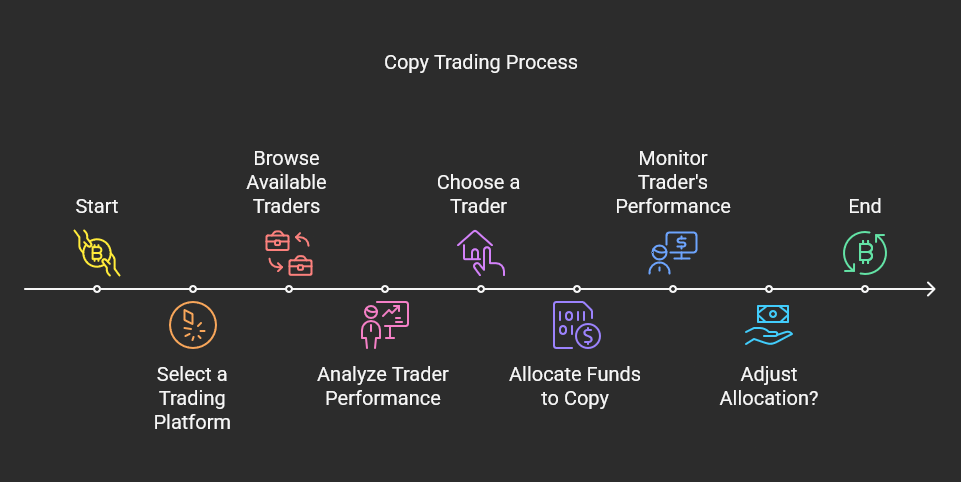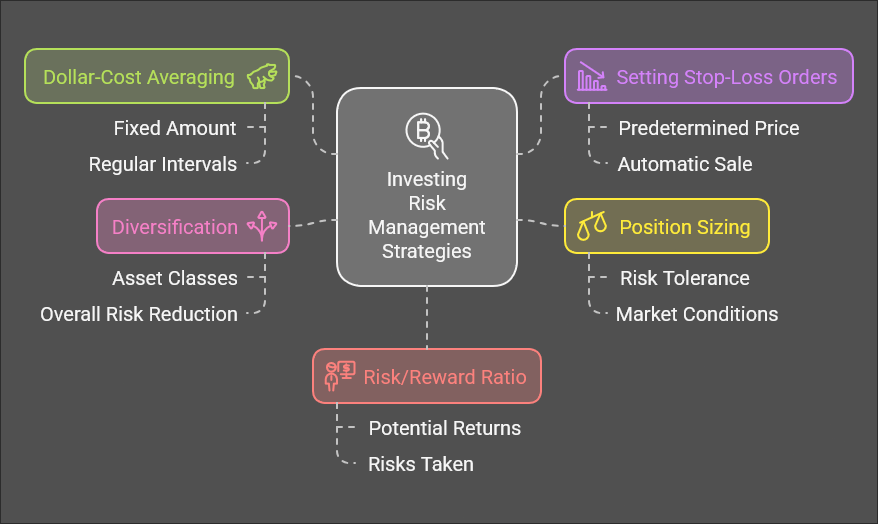Copy Trading vs. Traditional Trading: Which Strategy Prevails?
Copy Trading vs. Traditional Trading: Which Strategy is Superior?
In the world of trading, where every second counts and opportunities slip away like sand through fingers, investors often find themselves at a crossroads: should they embrace copy trading or stick to traditional trading methods? If you've ever found yourself glued to your phone during a meeting, contemplating the next big investment move while daydreaming about an ideal work-life balance, you're not alone.
Copy trading, a form of social trading that allows you to mirror the trades of successful traders, has emerged as an attractive option for those who lack the time to dive deep into market analysis. Meanwhile, traditional trading requires a more hands-on approach, involving extensive research and active management of your investment strategies.
The Allure of Copy Trading

With many copy trading platforms allowing for seamless access to diverse trading signals, investors can effortlessly tap into the strategies of successful traders. Imagine being able to replicate the trades of seasoned market veterans while sipping coffee at your favorite café or catching up on that Netflix series! This is where copy trade platforms come into play, offering mechanisms that allow you to follow successful traders with ease. Here are some benefits:
- Accessibility: Ideal for busy professionals who want exposure to financial markets without dedicating hours each day.
- Portfolio Diversification: By following multiple traders with different strategies, you can spread out risk.
- Passive Income Trading: A way to generate income without constantly monitoring your investments.
The Traditional Route: Worth the Time?

On the flip side, traditional trading provides its own unique advantages. For those willing to invest time in understanding market dynamics and developing their own strategies, this method can lead to greater profit potential and control over investments. Consider these points:
- Skill Development: Fine-tuning your abilities can lead to mastery in trade execution speed and risk management.
- Diverse Investment Opportunities: You can explore various asset classes beyond what typical copy traders might focus on.
- Personalized Strategies: Tailor your approach based on individual goals and market conditions.
So which approach ultimately wins? The answer may depend on your personal circumstances—how much time you have available versus how much control you're willing to relinquish. If you're still uncertain whether copy trading or traditional methods fit your style better, consider exploring our easy-to-follow end-of-day trading strategies and resources at
Conquer Wall Street.
"In investing, what is comfortable is rarely profitable." —Robert Arnott
No matter which path you choose, staying informed is key! And remember—whether you're copying moves or making them yourself—success in trading often comes down to learning from others and refining your approach over time.
Understanding the Concept of Copy Trading
A Closer Look at Copy Trading
Copy trading is more than just a buzzword; it's a powerful tool for investors seeking to maximize their returns without spending copious amounts of time analyzing market trends. In essence, it allows you to automatically replicate the trades of successful traders, enabling you to benefit from their expertise while maintaining your daily commitments.
At its core, copy trading intertwines two key concepts: social trading and automated trading. As part of a growing trader community, users can access trade signals from top performers, which can enhance your strategy and overall performance.
The Mechanics Behind Copy Trading

This process not only simplifies trading but also provides insights into the trading history and performance of traders you choose to follow. How does it actually work? Here’s a simple breakdown:
- Selecting a Trader: Users browse copy trade platforms to find traders whose strategies align with their financial goals. This may include factors like risk tolerance and historical performance metrics.
- Automated Execution: Once a trader is chosen, the platform automates the execution of trades based on that trader’s actions. This means every buy and sell order is mirrored in your account at the same time as theirs.
- Monitoring Performance: Most platforms provide detailed insights and analytics, allowing you to track how well the strategies are performing. This transparency helps in making informed decisions on whether to continue following or switch traders.
The Benefits You Can Reap
While some skeptics might wonder if copying someone else’s trades can lead to success, numerous advantages suggest otherwise:
- Easier Learning Curve: Beginner traders can grasp complex market behaviors by observing what successful traders do—an effective way to learn without risking substantial capital upfront.
- Diversification Made Simple: By following multiple traders across different asset classes (like forex or cryptocurrency), you can diversify your portfolio effortlessly, further enhancing risk management strategies.
- Access to Expertise: Leverage the skills of seasoned investors without dedicating endless hours to research—ideal for those with demanding jobs or busy lifestyles.
"The journey of a thousand miles begins with one step." —Lao Tzu
If you're considering diving into copy trading, it's essential to assess available options critically. Look for features such as brokerage fees comparison, investor protection in social trading networks, and user reviews of various copy traders. Investing wisely today could pave the way for a financially secure tomorrow!
No matter how you approach it—whether through traditional methods or innovative solutions like copy trading—the most crucial element remains: continuous learning and adaptation in this ever-evolving financial landscape.
The Mechanics of Traditional Trading

The Mechanics of Traditional Trading
Traditional trading is akin to running a marathon, rather than a quick sprint. It demands time, dedication, and a solid understanding of market mechanics. Whether you are venturing into stock market trading or dipping your toes into forex trading, the fundamentals are strikingly similar yet remarkably complex.
At its essence, traditional trading involves several core components:
- Market Research: Successful traders spend hours analyzing market trends, reading financial news, and studying economic indicators. This research forms the backbone of informed decision-making. Tools like charts and technical analysis come into play here—think of them as your trading roadmap.
- Trade Execution: Once a strategy is created, executing trades swiftly is critical. In fast-moving markets, trade execution speed can mean the difference between profit and loss. Traders often use specialized platforms that offer real-time quotes and analytics to make their trades more efficient.
- Risk Management: Every seasoned trader knows that proper risk management is crucial to long-term success. This includes setting stop-loss orders to minimize potential losses and diversifying portfolios to spread risk across different asset classes.
The Time Commitment
The time commitment for traditional trading can be significant. Many traders set aside dedicated hours each day (or even weeks) to analyze data and review their strategies. Despite this investment of effort, the rewards can be substantial—those who master traditional trading may find themselves with not just knowledge but also considerable returns on investment.
Benefits of Going Traditional
While copy trading offers convenience, traditional trading provides distinct advantages that many investors find appealing:
- In-Depth Knowledge: Engaging fully with the markets cultivates a deeper understanding of market behavior—knowledge that can be invaluable in volatile conditions.
- Control Over Investments: Individual traders have full control over their positions; they can react swiftly to market changes without waiting for a third party's actions.
No waiting for someone else’s coffee break! - Cultivation of Skills: Over time, traders develop a unique skill set including emotional resilience, analytical thinking, and strategic planning—abilities that are transferable beyond financial markets.
"The stock market is filled with individuals who know the price of everything but the value of nothing." —Philip Fisher
The mechanics behind traditional trading reveal it as a serious commitment—not just financially but also intellectually and emotionally. As you navigate these waters, remember that continuous learning is vital; honing your skills amidst evolving market conditions may ultimately lead you to success in your investment journey!
Pros and Cons of Copy Trading: Evaluating Investment Strategies
Pros and Cons: Copy Trading
While many platforms offer various features, it's crucial to understand how copy trading automates your investment approach while still requiring some level of personal trading insight. As appealing as the idea of copy trading may sound—especially when it promises to save you from hours of market analysis—it's important to weigh both the advantages and drawbacks before diving in. Here’s a closer look at what you might gain (or lose) by choosing this method.
Pros of Copy Trading

- Time-Saving: Copy trading allows you to engage in online trading without dedicating endless hours to research. This is particularly beneficial for busy professionals who can’t afford to be glued to their screens all day.
- Easier Access to Expertise: By following successful traders, you can leverage their insights and skills without needing years of experience yourself. It’s like having a personal finance coach but without the hefty fees!
- Diversification Made Easy: You can effortlessly diversify your portfolio by copying multiple traders with varied strategies across different markets, from stocks to cryptocurrency.
- Lower Barriers for Beginners: For those new on the scene, copy trading serves as an accessible entry point into the world of investing. It's like having training wheels while learning to ride the investment bike!
Cons of Copy Trading

- Lack of Control: When you copy someone else's trades, you're relinquishing control over your investment decisions. If they make a risky move or experience a loss, your account will reflect those decisions too.
- Potential for Underperformance: Not all traders are created equal! Some may appear successful based on past performance metrics, but market conditions can change rapidly. The trader you’re mimicking today may not be as effective tomorrow.
- Simplistic Approach: Relying too heavily on copy trading can hinder your own understanding of financial markets. You might miss out on developing critical skills that could serve you well in volatile situations.
- Fees and Costs: While many platforms tout low fees for copy trading, it’s essential to investigate further. Hidden costs related to spreads or withdrawal fees can erode your profits faster than a caffeine buzz fades after that third cup of coffee!
"It's not about how much money you make; it's about how much money you keep." —Robert Kiyosaki
In summary, while copy trading offers some exciting advantages—particularly for those pressed for time—it also comes with caveats that require consideration. Balancing convenience with control is key; finding a strategy that aligns with your risk tolerance and investment goals is crucial in today’s dynamic financial landscape.
If you're intrigued by the world of copy trading but still have questions about risk management or want guidance on which platforms suit your needs best, check out our extensive resources at Conquer Wall Street's Getting Started Training Videos.
Advantages and Disadvantages of Traditional Trading
Pros and Cons: Traditional Trading
When it comes to traditional trading, the age-old adage "no pain, no gain" rings true. This method requires a significant commitment of time and effort, but for many traders, the rewards can be substantial. Let's break down the pros and cons of this approach to understand its viability in today's fast-paced financial world.
Pros of Traditional Trading

- Control Over Your Investments: One of the most appealing aspects is that you call the shots! You dictate when to enter or exit trades based on your analysis without waiting for someone else to make that decision.
- Comprehensive Knowledge: Engaging in traditional trading fosters a deeper understanding of market mechanics. As you analyze trends and economic indicators, you develop insights that can enhance your decision-making—knowledge that often translates into better investment outcomes.
- Skill Development: The learning curve can be steep, but investing time in mastering trading skills pays off. You'll acquire abilities in technical analysis, risk management, and emotional discipline—skills not just beneficial for trading but applicable across various life domains.
- Diverse Investment Strategies: Traditional trading allows you to explore multiple asset classes—from stocks to options or even forex. This flexibility can lead to innovative approaches and unique investment opportunities that copy trading may not easily provide.
Cons of Traditional Trading

- Time-Intensive: Traditional trading is not for the faint of heart or those with busy schedules. It demands significant time investment for research, analysis, and market monitoring—time that many working professionals simply don’t have!
- Emotional Rollercoaster: Trading can stir up feelings from euphoria during wins to despair during losses. Managing these emotions is crucial; otherwise, one might make impulsive decisions based on fear rather than sound strategy.
- Potentially Higher Costs: Depending on your brokerage platform, transaction fees and commissions may vary. Frequent trades can rack up costs if not managed carefully—think of it as paying for every single attempt at a perfect soufflé!
- The Risk Factor: While mastering risk management is essential in traditional trading, there's always an element of unpredictability. Even seasoned traders face unexpected market downturns; having a solid plan helps mitigate but doesn’t eliminate risk entirely.
"The market is a device for transferring money from the impatient to the patient." —Warren Buffett
The decision between traditional trading and other methods ultimately hinges on personal preferences regarding control versus convenience. If you're willing to invest time into mastering the markets while embracing the accompanying risks—and perhaps derive some joy from it—you might find traditional trading rewarding both intellectually and financially.
If you're still pondering which approach aligns with your investment goals while managing your busy lifestyle, consider diving into our resources at Conquer Wall Street Blog, where we provide insights on everything from market trends to trader performance metrics!
Choosing the Best Copy Trading Platform

Choosing the Right Trading Platform
Look for platforms that provide resources to trade effectively, including mobile apps that cater to traders of all experience levels. When it comes to navigating the world of copy trading or traditional trading, the right trading platform can make all the difference. Think of it as your digital command center, where you can execute trades, monitor performance, and tap into the collective wisdom of successful traders—all from the comfort of your couch or office chair!
But with so many options on the market, how do you choose the ideal platform? Here are some critical factors to consider:
- User-Friendly Interface: A platform that’s easy to navigate is essential, especially for beginner traders. You don’t want to be buried in complicated charts when you could be making informed trades! Look for platforms that offer a clean layout and intuitive design.
- Access to Trade Signals: Many platforms provide insights and trade signals from top performers—crucial for those engaging in automated trading. Being able to follow successful traders in real time can significantly enhance your strategy.
- Brokerage Fees Comparison: Always consider what you’re paying! Lower fees can mean higher returns. Some platforms may advertise low commissions but charge hidden fees elsewhere—be vigilant in your research!
- Security Features: Your hard-earned money deserves protection. Ensure that the trading platform employs robust security protocols, including encryption and two-factor authentication. After all, we want our investments safe, not left out in the wild!
- Diverse Asset Options: For those interested in both stocks and cryptocurrency trading, a flexible platform that supports multiple asset classes will cater to your diverse investment strategies.
- Community Support: Platforms with an active trader community can be invaluable. Engaging with others allows for shared learning experiences and insights that could enrich your trading journey.
"The best investment you can make is in yourself." —Warren Buffett
Selecting a trading platform isn’t just about features; it’s about finding an environment that resonates with your investment goals and lifestyle. If you’re already feeling overwhelmed by choices or need help getting started, consider checking out detailed guides or training resources at Conquer Wall Street's Getting Started Training Videos. Your optimal trading experience awaits!
No matter which path you choose—copy trading or traditional methods—invest wisely by leveraging technology to maximize efficiency while minimizing risk. After all, smart investing is not just about making money; it's about making informed decisions!
Optimizing Risk Management in Copy Trading

Effective Risk Management Strategies
Using features like stop-loss orders is essential for both copy and traditional trading to manage risk per trade effectively. When embarking on your trading journey, whether through copy trading or traditional methods, robust risk management should be at the forefront of your strategy. It's like wearing a seatbelt in a car; you may not think you'll need it, but when the unexpected happens, you'll be glad you had one!
Here are some effective risk management strategies tailored for both approaches:
Diversification: Your Safety Net
Diversification is fundamental in managing risk across any trading portfolio. By spreading your investments across various asset classes—such as stocks, bonds, and cryptocurrencies—you can mitigate potential losses. If one sector underperforms, others may compensate with gains.
- Copy Trading: When using copy trade platforms, consider following multiple traders who employ different strategies. This way, you buffer against the poor performance of any single trader.
- Traditional Trading: Actively diversify your holdings by investing in various industries or geographic regions. For example, tech stocks can soar while energy stocks falter; balance is key!
Setting Stop-Loss Orders: The Silent Guardian
Stop-loss orders act as a safety net by automatically selling an asset when it drops to a predetermined price. This helps you limit potential losses without needing constant monitoring.
- For Copy Traders: Many copy trading platforms allow you to set parameters for stop-loss orders based on the traders you're mimicking. This ensures that even if they make a risky move, you're protected to some extent.
- For Traditional Traders: Implement stop-loss orders on your trades to manage downside risk effectively. It's like having an escape plan when you accidentally stumble into a bad party!
Position Sizing: Know Your Limits
Your investment size should reflect your overall portfolio and risk tolerance. Avoid putting all your eggs in one basket—unless that basket is exceptionally sturdy!
- Copy Trading Insight: When choosing whom to copy, consider their position sizing strategy. A trader who risks only a small percentage of their capital per trade may be more prudent than someone going all-in on every move.
- Traditional Approach: Apply the rule of thumb for position sizing: never invest more than 1-2% of your total account balance on a single trade. This minimizes potential financial harm while allowing room for growth.
Regular Review and Adjustment: Staying Agile
The financial markets are dynamic; what works today may not work tomorrow. Regularly reviewing and adjusting your strategies is essential to staying ahead.
- For Copy Traders: Keep track of how well the traders you're following perform over time. If they start underperforming significantly without adapting their strategy, it might be time to cut ties—and perhaps find new successful traders to follow.
- For Traditional Traders: Analyze your investment performance periodically; adjust strategies based on market conditions or personal financial goals—think of it as spring cleaning for your portfolio!
"Risk comes from not knowing what you're doing." —Warren Buffett
No matter which path you choose in trading—be it copy trading or traditional methods—effective risk management will serve as the backbone of your investment strategy. By integrating these practices into your approach, you'll be better equipped to navigate the roller-coaster ride that is the financial market.
If you'd like more insights into mastering risk management techniques or want tips tailored specifically for beginners, don’t hesitate to check out our extensive resources at Conquer Wall Street's Getting Started Training Videos. A safer investing journey awaits!
The Role of Technology: From Trading Bots to Forex Signals Providers

The Role of Technology: From Trading Bots to Forex Signals Providers
In the modern trading landscape, technology serves as both a compass and a safety net. For investors who juggle careers alongside their trading endeavors, tools like trading bots and forex signals providers are invaluable. They help bridge the gap between time constraints and market opportunities, allowing traders to make informed decisions—even when they can't be physically present.
Trading Bots: Your Automated Allies
Imagine having a tireless assistant who can analyze market trends while you’re stuck in back-to-back meetings. Trading bots function as automated trading systems that execute trades based on predetermined criteria, optimizing your investment strategies without requiring constant supervision. Here’s how they enhance your trading experience:
- 24/7 Market Engagement: Unlike human traders, bots can operate around the clock—ideal for financial markets that never sleep. This means you won’t miss out on critical opportunities just because you’re catching up on your beauty sleep.
- Emotion-Free Trading: Humans are prone to emotional decision-making, especially during volatile market conditions. Bots follow pre-set algorithms and rules, helping you stick to your strategy without succumbing to fear or greed.
- Backtesting Capabilities: Before deploying a bot for live trading, many platforms allow you to backtest strategies against historical data. This feature helps fine-tune your approach—a must for anyone serious about their financial journey!
Forex Signals Providers: Tapping Into Expertise
If you're not ready to dive into automated trading but still want expert insights, forex signals providers can be a game-changer. These services offer trade signals based on thorough analysis from seasoned traders or algorithms tailored for specific markets. Here’s what makes them essential:
- Timely Insights: Forex signals provide alerts on potential trade setups—think of them as personal alerts straight from the market, keeping you informed even when you're busy with work.
- Diversified Strategies: Many signal providers cover multiple trading styles—short-term (scalping), mid-term (swing), and long-term (position)—allowing you to select methods that align with your risk tolerance and time commitment.
- User-Friendly Platforms: Many forex signals come integrated with mobile trading apps that cater specifically to beginners. This means you can easily access expert advice right from your pocket while waiting in line for coffee!
The evolution of technology in trading highlights its importance in simplifying complex decisions. Whether through trading bots or forex signals providers, leveraging these tools can significantly enhance your ability to navigate today’s dynamic financial markets.
No matter which route you choose—be it traditional methods or modern automation—embracing technology will help position yourself for success while managing those precious hours in your day!
The Verdict: Which Strategy is Best for Copy Trading?
If you're new to trading, copy trading may offer a gentler entry point into financial markets while still granting control over your account. Deciding between copy trading and traditional trading ultimately hinges on a few key personal factors—your lifestyle, desired level of involvement, and risk tolerance. It’s akin to choosing between a leisurely bicycle ride or a high-stakes race; both have their merits, but only one may align with your current situation.
Copy Trading: The Safe Bet for Busy Bees

If you're juggling a full-time job or other commitments that leave little room for market analysis, copy trading could be your golden ticket. Here’s why:
- Time Efficiency: Copy trading platforms allow you to replicate the strategies of seasoned traders, freeing you from the hours spent pouring over charts—perfect for those who prefer sipping lattes over trading candles!
- Community Support: Engaging with a network of traders can provide valuable insights and camaraderie. You’re not just following trades; you're part of a trader community, sharing ideas and strategies along the way.
- Less Stress: With automated systems in place, the anxiety of daily market fluctuations can be significantly reduced. Instead of worrying about every price dip, you can relax knowing that you have professionals managing your investments.
Traditional Trading: For the Control Enthusiasts

If your heart races at the thought of conducting research and crafting personalized investment strategies, traditional trading may be more in tune with your aspirations. Consider these compelling points:
- Full Control: You call the shots! Whether it’s deciding when to sell or navigating complex financial instruments, traditional trading allows you to tailor decisions based on real-time data.
- Skill Mastery: If you relish learning and mastering new skills, the traditional route will help sharpen your analytical abilities while enhancing emotional resilience—qualities that are invaluable in any career!
- Satisfaction of DIY Investing: There’s a unique thrill in seeing your meticulously crafted strategy play out successfully. It’s like cooking your favorite dish; nothing beats savoring the fruits of your labor!
The Middle Ground: A Hybrid Approach
If you're still torn between these two worlds, why not consider a hybrid approach? Engage in copy trading during particularly busy periods while actively managing investments when time permits. This way, you get the best of both worlds! Think of it as having cake and eating it too—just make sure it's not too sweet for your portfolio!
No matter which path resonates with you more—be it following successful traders or crafting your own strategies—the most important thing is to stay informed and adaptable. With continuous learning and informed decision-making, you'll uncover investment opportunities tailored to fit snugly within your lifestyle.
Your trading journey awaits! So take a moment to reflect on what suits you best—and dive in with confidence!
As the landscape of online trading continues to evolve with new technologies like crypto copy trading apps emerging on the scene daily; staying informed about these methodologies ensures you remain at the forefront—ready to conquer any challenges Wall Street throws your way!
Frequently Asked Questions About Copy Trading
What is copy trading and how does it work?
Copy trading is a form of trading that allows investors to automatically replicate the trades of experienced traders. By using a copy trading platform, individuals can choose a trader to copy based on their performance and trading strategies. When the selected trader makes a trade, the platform automatically executes the same trade in the user's trading account. This method is particularly beneficial for those who are new to trading or lack the time to actively manage their investments, as it enables them to benefit from the expertise of successful traders.
How does
copy trading differ from
traditional trading?
The primary difference between copy trading and traditional trading lies in the level of involvement and expertise required. In traditional trading, individuals must research and analyze the markets, develop their own trading strategies, and make independent decisions. This can be time-consuming and requires a solid understanding of market conditions. In contrast, copy trading allows users to leverage the knowledge and experience of others, making it a more accessible option for those who may not be familiar with the complexities of the financial markets.
Who should consider copy trading?
Copy trading is ideal for various types of investors, including beginner traders who may feel overwhelmed by the prospect of trading independently. It is also suitable for busy professionals who want to invest but do not have the time to monitor the markets continuously. Additionally, experienced traders may use copy trading to diversify their portfolios by mirroring the trades of other successful traders. Ultimately, anyone looking to simplify their investment approach while still participating in the financial markets may find copy trading appealing.
What are the risks associated with copy trading?
Copy trading can offer a more straightforward path to investing, it is not without risks. Investors may encounter situations where the trader may not perform as expected, leading to losses. Additionally, relying solely on another trader's expertise can lead to a lack of personal trading experience and understanding of the market. It is essential to assess your risk tolerance and to diversify your investments rather than putting all your funds into one trader's portfolio. Understanding the trading history and past.

Copyrights All Rights Reserved | Conquer Wall Street LLC
DISCLOSURE: If you do not agree with any term or provision of our Terms and Conditions you should not use our website, services, content or information. Please be advised that your continued use of this website, services, content or information provided shall indicate your consent and agreement to our Terms and Conditions. Please carefully read the Terms and Conditions and if you disagree with any of our policies, please exit from this website immediately.
Conquer Wall Street LLC is not an investment advisor and is not registered with the U.S. Securities and Exchange Commission or the Financial Industry Regulatory Authority. Any and all owners, employees, agents or representatives of Conquer Wall Street LLC are not acting as investment advisors and are not registered with the U.S. Securities and Exchange Commission or the Financial Industry Regulatory Authority.
The content on any Conquer Wall Street LLC websites, products or communication is for educational and informational purposes only. Nothing in its products, services, or communications shall be construed as a solicitation and/or recommendation to buy or sell a security. Trading stocks, options, futures, and other securities involves risk. The risk of loss in trading securities can be substantial. The risk involved with trading stocks, options, futures, and other securities is not suitable for all investors. Prior to buying or selling any stock, future, or other security, an investor must evaluate his/her own personal financial situation and consider all relevant risk factors. Prior to buying or selling an option, an investor must evaluate his/her own personal financial situation and consider all relevant risk factors. See also: Characteristics and Risks of Standardized Options.
The information provided within this website is not intended to be used as the sole basis of any investment decisions, nor should it be construed as advice designed to meet the investment needs of any particular investor. Nothing in our research constitutes legal, accounting or tax advice or individually tailored investment advice. Any and all research, information, products, and/or communications are prepared for general circulation and are prepared without regard to the individual financial circumstances and objectives of persons who receive or obtain access to it. Our research is based on sources that we believe to be reliable. Conquer Wall Street LLC does not make any representation or warranty, expressed or implied, as to the accuracy of our research, the completeness thereof, or its correctness or make any guarantee or other promise as to any results that may be obtained from using our research or fitness for a particular purpose. To the maximum extent permitted by law, neither we, any of our affiliates, nor any other person shall have any liability whatsoever to any person for any loss or expense, whether direct, indirect, consequential, incidental or otherwise, arising from or relating in any way to any use of or reliance on our research or the information contained therein. Some discussions contain forward looking statements which are based on current expectations and differences can be expected. All of our research, including but not limited to opinions and information contained therein, reflects our judgment as of the publication or other dissemination date of the research and is subject to change without notice. Conquer Wall Street LLC expressly disclaim any responsibility to update such research. Investing involves substantial risk. Past performance is no guarantee of future results, and a loss of original capital may occur. No one receiving or accessing our research should make any investment decision without first consulting his/her own personal financial advisor and conducting his/her own research and due diligence, including but not limited to reviewing any applicable prospectuses, reports, and other public filings of the issuer of any securities being considered. None of the information presented should be construed as an offer to sell or buy any particular security. Each individual has a duty to use their best judgment when investing.
DISCLAIMER: Past performance is no guarantee of future results. This product is for educational and informational purposes only. Practical application of the products herein is at your own risk and Conquer Wall Street LLC, its owners, employees, partners and representatives assume no responsibility of liability for any use or improper use of the product(s). You should contact your financial advisor for specific financial advice tailored to your personal circumstances and risk tolerances. Any trades shown are hypothetical examples. Actual results may differ. Nothing contained on this website, its services or informational products constitutes a recommendation regarding any security illustrated.
CFTC RULE 4.41 – HYPOTHETICAL OR SIMULATED PERFORMANCE RESULTS HAVE CERTAIN LIMITATIONS. UNLIKE AN ACTUAL PERFORMANCE RECORD, SIMULATED RESULTS DO NOT REPRESENT ACTUAL TRADING. ALSO, SINCE THE TRADES HAVE NOT BEEN EXECUTED, THE RESULTS MAY HAVE UNDER-OR-OVER COMPENSATED FOR THE IMPACT, IF ANY, OF CERTAIN MARKET FACTORS, SUCH AS LACK OF LIQUIDITY, SIMULATED TRADING PROGRAMS IN GENERAL ARE ALSO SUBJECT TO THE FACT THAT THEY ARE DESIGNED WITH THE BENEFIT OF HINDSIGHT. NO REPRESENTATION IS BEING MADE THAT ANY ACCOUNT WILL OR IS LIKELY TO ACHIEVE PROFIT OR LOSSES SIMILAR TO THOSE SHOWN.



